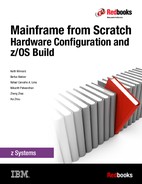

Overview
This chapter is the starting point for providing you with the high-level information to understand the scope of our initial build and how we approach it.
This chapter includes the following topics:
1.1 Introduction
The simplest way to explain how to set up a mainframe hardware environment from scratch and install z/OS software on it is to show you. To this end, we defined a scenario and used the standard tool sets that are available to build that scenario.
The process of starting from scratch to establishing a single basic operational environment is described in this book. The descriptions are based on the actual design, plan, and build of the scenario by using dedicated hardware and software in a controlled laboratory environment. You see how it is built in practical and real steps.
Throughout the book, we offer hints and tips that can help improve your understanding of the processes, and help you consider what makes it more applicable to your environment.
1.1.1 Overview of approach
The approach that we take is designed to help you in the following ways:
•Design a scenario so you can see what the end solution looks like
•Show you how we created the plan to build the scenario
•Show you the steps that we took to build the scenario
Each step aims at building your confidence and expertise with the following intentions:
•Keep the steps simple; you might be new to the z Systems platform
•Reduce complexity by breaking down the process into manageable phases and steps
•Keep the language simple
•Use the latest hardware and software levels where possible
•Be practical in the approach
•Provide you with references to other materials that help increase your understanding
•Show how a structured approach can help to ease effort and minimize repetition
1.2 Scenario
You are ready to start the process with us. The first topic that we must cover is the destination of this process, which is the active scenario. The process shows you how to build this scenario.
You can use this book to see how certain activities were planned or completed. If you printed a hardcopy of this book, you can make notes in the margins to which you can refer later.
1.2.1 System scenario
The initial build in shown in Figure 1-1. The following logical partitions (LPARs) are used:
•Customized Offering Driver (COD): This LPAR accommodates the driver system. It is a predefined z/OS system that is loaded and used to install the ServerPac.
•COSP: This LPAR is the z/OS V2R2 system that we build by using the ServerPac process. In addition to z/OS, we use a separate ServerPac to install DB2 V11 into this LPAR.

Figure 1-1 Initial build
Consider the following points regarding our scenario:
•All the LPARS run on an IBM z13 N63. No other CPCs are included in this scenario.
•A single DS8000 DASD provides all of the disks for our scenario.
•No tape drives are available.
•One Hardware Management Console (HMC) is used to configure the z13.
You might want to add more LPARs or Coupling Facilities (CFs) later to suit your requirements. However, this scenario is aimed at providing you with a base on which you can develop your infrastructure, as shown in Figure 1-1.
Each z/OS LPAR includes the following layers:
•A System Software layer that consists of z/OS system files, which are critical for the operating system to run.
•A basic Operations layer that contains elements that define the LPAR’s role in relationship to its environment.
•A partial Data and Database layer that is unique to the individual LPAR (and Sysplex), which further defines the roles and responsibilities of the environment.
..................Content has been hidden....................
You can't read the all page of ebook, please click here login for view all page.
